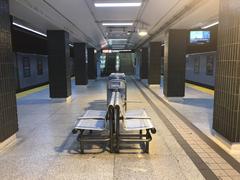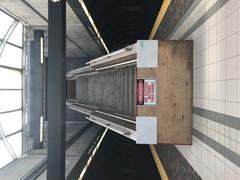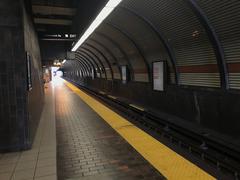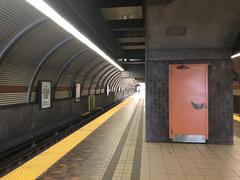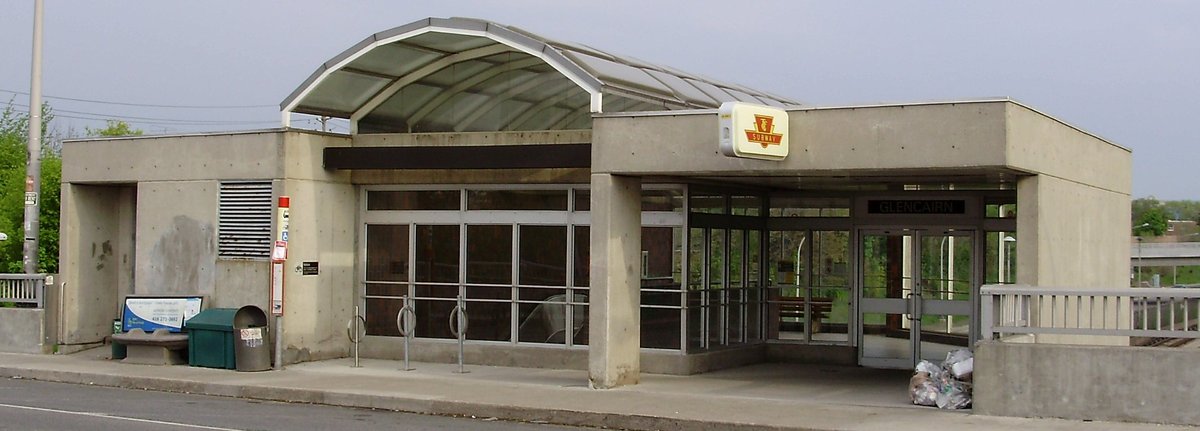
Glencairn Toronto Visiting Hours, Tickets, and Historical Sites Guide
Date: 15/06/2025
Introduction to Glencairn Toronto Historical Site
Glencairn, situated in Toronto’s North York district, is a neighborhood deeply rooted in history and characterized by vibrant multiculturalism. This area offers visitors a compelling mix of historical significance, urban growth, and a lively community atmosphere. Its evolution, from Indigenous territory utilized by the Huron-Wendat and Mississaugas of the Credit, through colonial settlement and postwar suburbanization, mirrors Toronto’s broader development (historyoftoronto.ca). Today, Glencairn is notable for heritage preservation, dynamic urban transformation, community events, landmark sites such as the Glencairn Monument, and diverse cultural institutions.
As a designated Major Transit Station Area (MTSA) around Glencairn Subway Station, the neighborhood is at the forefront of transit-oriented, sustainable urban planning (City of Toronto Growing Marlee-Glencairn Study). Visitors can enjoy serene parks, self-guided history walks, and a culinary scene reflecting Glencairn’s multicultural fabric.
This guide offers a comprehensive overview of Glencairn’s history, landmarks, transit access, visitor advice, and nearby attractions. Whether you are a history enthusiast, urban explorer, or family seeking green spaces, Glencairn delivers an authentic Toronto experience. For practical information, consult resources such as the Toronto Historical Society and the City of Toronto’s planning portals (Toronto Historical Society; TTC).
Contents
- Introduction
- Glencairn Toronto History: From Indigenous Lands to Urban Neighborhood
- Indigenous Presence and Early Settlement
- Colonial Era and Rural Beginnings
- Urbanization and Suburban Growth
- Demographic Shifts and Cultural Significance
- Things to Do in Glencairn Toronto: Visitor Highlights
- Parks and Green Spaces
- Cultural Sites
- Walking Tours
- Shopping and Dining
- How to Get to Glencairn
- Accessibility and Visitor Tips
- Nearby Attractions and Related Toronto Historical Sites
- Preservation and Future Outlook
- Glencairn Toronto: Transit, Development, and Visiting Tips
- Urban Transformation and Planning Initiatives
- Residential and Mixed-Use Development
- Transit Connectivity
- Community Character and Demographic Shifts
- Green Spaces and Sustainability
- Visitor Experience and Practical Tips
- Frequently Asked Questions (FAQ)
- Staying Informed
- Welcome to Glencairn Toronto: A Visitor’s Guide to Historical Sites and Attractions
- Architectural and Cultural Landmarks
- Parks and Outdoor Activities
- Religious and Cultural Institutions
- Shopping, Dining, and Local Experiences
- Proximity to Major Toronto Attractions
- Arts and Community Events
- Visiting Hours and Tickets
- Transportation and Accessibility
- Visitor Tips and Practical Information
- FAQs
- Visuals and Interactive Resources
- Discovering Glencairn Monument: A Historical Landmark in Toronto
- History and Cultural Significance
- Visiting Hours and Location
- Tickets and Entry
- Accessibility
- Special Events and Tours
- Photography Tips
- Nearby Attractions and Amenities
- Getting to Glencairn Monument
- Safety and Visitor Tips
- FAQs
- Plan Your Visit
- Summary and Visitor Recommendations for Glencairn Toronto
- Sources and Further Reading
Exploring Glencairn: A Historical and Cultural Guide to Toronto’s North York Neighborhood
Glencairn Toronto History: From Indigenous Lands to Urban Neighborhood
Indigenous Presence and Early Settlement
Long before European colonization, the land now known as Glencairn was home to Indigenous peoples, including the Huron-Wendat, Haudenosaunee, and the Mississaugas of the Credit. These groups used the land for hunting, fishing, and travel along the Toronto Carrying-Place Trail, a vital route connecting Lake Ontario to Lake Simcoe (historyoftoronto.ca). The Toronto Purchase of 1787 and its 1805 revision transferred much of this land to the British Crown, paving the way for European settlement.
Colonial Era and Rural Beginnings
Throughout the 19th century, Glencairn remained rural, dominated by farmland and woodlots. Settlers, including many Loyalists and Scottish immigrants, established farms and small communities along key corridors like Yonge and Bathurst Streets. The neighborhood’s name itself reflects its Scottish roots.
Urbanization and Suburban Growth
Post-World War II, Glencairn transformed from rural acreage into a middle-class suburban neighborhood. The expansion of public transit and postwar immigration made it attractive for new residents. Jewish families were among the first to settle here in large numbers, establishing synagogues, schools, and community centers that still serve as cultural pillars.
Demographic Shifts and Cultural Significance
Glencairn has since become increasingly diverse, welcoming Italian, Portuguese, Filipino, South Asian, and Chinese communities. This multiculturalism is evident in local businesses, religious institutions, and community festivals.
Things to Do in Glencairn Toronto: Visitor Highlights
Parks and Green Spaces
Relax at Viewmount Park or Wenderly Park—ideal for picnics, family outings, or strolls among mature trees and landscaped gardens.
Cultural Sites
While primarily residential, Glencairn features notable synagogues and Jewish community centers. Some offer public cultural events—check individual websites for details.
Walking Tours
Discover the neighborhood’s architectural diversity on self-guided walks, from postwar bungalows to contemporary infill homes. Keep an eye out for heritage plaques and preserved streetscapes.
Shopping and Dining
Explore commercial hubs along Eglinton West and Lawrence Plaza, where you’ll find everything from kosher markets and Italian bakeries to international eateries.
How to Get to Glencairn
Glencairn is easily accessed via TTC Line 1 (Yonge-University) at Glencairn Station. Several bus routes also serve the area, providing seamless connections throughout Toronto.
Accessibility and Visitor Tips
- Best Time to Visit: Spring through fall is ideal for enjoying parks and walking tours.
- Family-Friendly: Parks and community amenities make Glencairn welcoming for families.
- Guided Tours: While there are no tours exclusive to Glencairn, some broader Toronto walking tours include it.
Nearby Attractions and Related Toronto Historical Sites
- Lawrence Manor and Forest Hill: Explore nearby neighborhoods known for historic homes and cultural sites.
- Toronto Carrying-Place Trail: Learn about this important Indigenous and trading route.
- North York Civic Centre: Visit for community events and local history exhibits.
Preservation and Future Outlook
Community advocacy in Glencairn focuses on balancing heritage preservation with sustainable growth. The neighborhood’s MTSA status ensures that future development emphasizes transit access, green spaces, and public engagement, maintaining Glencairn’s unique identity within Toronto.
Glencairn Toronto: Transit, Development, and Visiting Tips for a Thriving Midtown Neighbourhood
Urban Transformation and Planning Initiatives
Glencairn’s ongoing transformation is guided by the City of Toronto’s Growing Marlee-Glencairn Study, which seeks to manage growth, promote mixed-use development, and create a resilient, pedestrian-friendly environment. The area, designated as a Major Transit Station Area, must meet density targets to support robust transit and community life.
Residential and Mixed-Use Development
Significant new projects are reshaping the area:
- The Wilde Condos: A 30-storey, 362-unit building set to open by 2029 (Wilde Condos).
- Viewmount Avenue Towers: Proposed 35- and 39-storey towers near the station (Storeys).
- Marlee Avenue High-Rises: Mixed-use 26-storey tower integrating amenities and transit (UrbanToronto).
Emphasis is placed on walkability, green roofs, and sustainability.
Transit Connectivity
Glencairn Subway Station on Line 1 provides frequent service to downtown and York University. The area is also close to Lawrence West Station and the future Eglinton Crosstown LRT. Cycling infrastructure, including bike lanes on Marlee Avenue and connections to the York-Beltline Trail, supports active transportation (City of Toronto).
Community Character and Demographic Shifts
Glencairn is evolving, attracting young professionals, families, and students, while retaining long-time residents. The area’s diversity enriches local businesses, schools, and community centers. The city continues to engage with Indigenous and equity-seeking groups to ensure inclusive development (RENX).
Green Spaces and Sustainability
Urban greening is a priority, with new developments incorporating green roofs and energy-efficient features (City of Toronto Vision and Principles). Parks such as Glen Long Community Centre and the York-Beltline Trail offer recreational opportunities and natural corridors.
Visitor Experience and Practical Tips
- Getting There: TTC Line 1 to Glencairn Station; also served by bus routes.
- Visiting Hours & Accessibility: Public parks and spaces are open year-round. Community centers typically operate 9 AM–9 PM; check ahead for details.
- Events: Community pop-ups, planning consultations, and festivals are frequent (City of Toronto Events).
- Active Development: Ongoing construction reflects the area’s sustainable intensification.
Frequently Asked Questions (FAQ)
Q: How do I get to Glencairn by transit?
A: Take TTC Line 1 to Glencairn Station; multiple bus routes also serve the area.
Q: Are there development-focused tours?
A: The City of Toronto occasionally hosts public consultations and walking tours—check event listings.
Q: What amenities are nearby?
A: Parks, community centers, retail, and cafes are all accessible.
Q: Is cycling supported?
A: Yes, with dedicated bike lanes and trail connections.
Q: When is the best time to visit?
A: Year-round, with spring and summer best for outdoor activities.
Staying Informed
Stay updated on Glencairn’s growth through City of Toronto e-updates and planning resources. The Audiala app also provides neighborhood news and transit alerts.
Welcome to Glencairn Toronto: A Visitor’s Guide to Historical Sites and Attractions
Architectural and Cultural Landmarks in Glencairn
Heritage Properties
Glencairn is home to notable heritage properties, such as 94 Cortleigh Boulevard, designated for its cultural and architectural significance (City of Toronto By-law). While privately owned, these homes contribute to the neighborhood’s historical landscape.
Glencairn Museum Clarification
The Glencairn Museum referenced in some sources is located in Bryn Athyn, Pennsylvania—not Toronto. For cultural experiences, explore Glencairn’s local institutions and events.
Parks, Green Spaces, and Outdoor Activities
Enjoy the Beltline Trail, Cedarvale Park, and Eglinton Park for jogging, cycling, and family outings (Toronto Parks). Seasonal garden tours highlight Glencairn’s horticultural charm (Through the Garden Gate).
Religious and Cultural Institutions
Visit synagogues such as Beth Torah Congregation and Beth Sholom Synagogue, or engage in programs at the Prosserman Jewish Community Centre (Prosserman JCC).
Shopping, Dining, and Local Experiences
Explore Eglinton West and Marlee Avenue for diverse dining, including Caribbean, Jewish, and Italian cuisine (Toronto Food Scene). Summer brings farmers’ markets and street festivals (Toronto June Events).
Proximity to Major Toronto Attractions
Glencairn offers easy access to:
- Casa Loma (Casa Loma’s official site)
- Royal Ontario Museum (ROM) (Royal Ontario Museum)
- Allan Gardens Conservatory
- Toronto Reference Library
Arts, Festivals, and Community Events
Enjoy festivals like the Toronto Caribbean Carnival’s Official Launch and Lavazza Inclucity Festival (Toronto Festivals). Visit nearby galleries such as the Dimensions Gallery and Art Gallery of Ontario (AGO) (AGO Events).
Visiting Hours and Tickets
Most parks and outdoor spaces are open year-round and free. Heritage homes like 94 Cortleigh Blvd are private and viewable from the street. Major attractions such as Casa Loma and the ROM require tickets—check official websites for details.
Transportation and Accessibility
Glencairn is served by TTC Line 1 at Glencairn Station and is walkable, with cycling encouraged (TTC Info; Toronto Walkable Neighbourhoods). Limited street parking is available; public transit is recommended.
Visitor Tips and Practical Information
- Best Times to Visit: Late spring to early fall for outdoor activities; winter for indoor cultural events.
- Safety: Glencairn is family-friendly and safe, with accessible public spaces.
- Etiquette: Respect customs at religious sites and observe photography rules.
Frequently Asked Questions (FAQ)
Q: What are Glencairn’s visiting hours?
A: Outdoor spaces are generally open during daylight hours; check individual attractions for specific hours.
Q: Are there guided tours?
A: No dedicated tours, but broader Toronto walking and cycling tours may include Glencairn.
Q: Is public transit available?
A: Yes, via Glencairn subway station.
Q: Are tickets required?
A: Parks are free; museums and heritage sites may require tickets.
Visuals and Interactive Resources
Access interactive maps on the City of Toronto website. Virtual tours and images of major attractions are available online.
Discovering Glencairn Monument: A Historical Landmark in Toronto
History and Cultural Significance
The Glencairn Monument, dedicated in 1952, honors early Scottish settlers and symbolizes the neighborhood’s agricultural and cultural roots. Crafted from local stone, it features carvings depicting scenes from 19th-century settler life.
Visiting Hours and Location
Located at Glencairn Avenue and Keele Street, the monument is outdoors and viewable at all times.
Tickets and Entry
The monument is free to visit. Guided historical walking tours including the monument may require tickets, available through the Toronto Historical Society.
Accessibility
The site is wheelchair accessible, with paved paths and accessible transit via Glencairn Station.
Special Events and Guided Tours
Cultural events, including Scottish heritage festivals and art exhibits, are held throughout the year. Guided tours are available seasonally (Toronto Historical Society).
Photography Tips
Golden hour provides the best lighting for photographs of the monument’s detailed stonework. Please respect the site and avoid climbing.
Nearby Attractions and Amenities
Visit Glencairn Community Park, local cafes, and Yorkdale Shopping Centre for a complete outing.
Getting to Glencairn Monument
- Public Transit: Close to Glencairn Station on Line 1; multiple bus routes are nearby. Use TTC and Moovit app for route planning.
- Parking: Limited street parking; public transit is recommended.
Safety and Visitor Tips
Glencairn is a safe neighborhood. Observe standard precautions, especially at night, and secure valuables on transit.
FAQs
Q: Is the monument open year-round?
A: Yes, it is accessible 24/7.
Q: Are there guided tours?
A: Yes, seasonally via the Toronto Historical Society.
Q: Is there an admission fee?
A: No, visiting the monument is free.
Q: Is the site accessible?
A: Yes, paths accommodate mobility devices.
Q: Can I take photos?
A: Yes, photography is encouraged.
Plan Your Visit
For the best experience, download the Audiala app for self-guided audio tours and event updates.
Summary and Visitor Recommendations for Glencairn Toronto
Glencairn exemplifies Toronto’s historical richness and modern evolution. Visitors can immerse themselves in a neighborhood where Indigenous heritage, Scottish settlement, and multicultural communities intersect. The Glencairn Monument and heritage homes offer tangible links to the past, while the area’s MTSA status reflects a commitment to sustainable, accessible growth (City of Toronto Growing Marlee-Glencairn Study).
With excellent transit, cycling infrastructure, and proximity to major attractions like Casa Loma and the ROM, Glencairn is accessible and family-friendly. Enjoy historical sites, green spaces, diverse dining, and seasonal community events. Download the Audiala app for personalized guides and stay informed through city resources (Audiala app).
Sources and Further Reading
- Exploring Glencairn: A Historical and Cultural Guide to Toronto’s North York Neighborhood, 2025, historyoftoronto.ca
- Glencairn Toronto: Transit, Development, and Visiting Tips for a Thriving Midtown Neighbourhood, 2025, City of Toronto City of Toronto
- Exploring Glencairn Toronto: Visiting Hours, Tickets, and Top Historical Sites, 2025, Toronto Parks
- Visiting Glencairn Monument: History, Hours, Tickets & Visitor Tips, 2025, Toronto Historical Society
- Toronto Transit Commission (TTC)
- Audiala App

